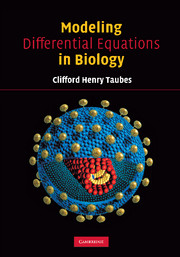Book contents
- Frontmatter
- Contents
- Preface
- Chapter 1 Introduction
- Chapter 2 Exponential Growth
- Chapter 3 Introduction to Differential Equations
- Chapter 4 Stability in a One-Component System
- Chapter 5 Systems of First-Order Differential Equations
- Chapter 6 Phase Plane Analysis
- Chapter 7 Introduction to Vectors
- Chapter 8 Equilibrium in Two-Component, Linear Systems
- Chapter 9 Stability in Nonlinear Systems
- Chapter 10 Nonlinear Stability Revisited
- Chapter 11 Matrix Notation
- Chapter 12 Remarks About Australian Predators
- Chapter 13 Introduction to Advection
- Chapter 14 Diffusion Equations
- Chapter 15 Two Key Properties of the Advection and Diffusion Equations
- Chapter 16 The No-Trawling Zone
- Chapter 17 Separation of Variables
- Chapter 18 The Diffusion Equation and Pattern Formation
- Chapter 19 Stability Criterion
- Chapter 20 Summary of Advection/Diffusion
- Chapter 21 Traveling Waves
- Chapter 22 Traveling Wave Velocities
- Chapter 23 Periodic Solutions
- Chapter 24 Fast and Slow
- Chapter 25 Estimating Elapsed Time
- Chapter 26 Switches
- Chapter 27 Testing for Periodicity
- Chapter 28 Causes of Chaos
- Extra Exercises and Solutions
- Index
Chapter 18 - The Diffusion Equation and Pattern Formation
Published online by Cambridge University Press: 05 June 2012
- Frontmatter
- Contents
- Preface
- Chapter 1 Introduction
- Chapter 2 Exponential Growth
- Chapter 3 Introduction to Differential Equations
- Chapter 4 Stability in a One-Component System
- Chapter 5 Systems of First-Order Differential Equations
- Chapter 6 Phase Plane Analysis
- Chapter 7 Introduction to Vectors
- Chapter 8 Equilibrium in Two-Component, Linear Systems
- Chapter 9 Stability in Nonlinear Systems
- Chapter 10 Nonlinear Stability Revisited
- Chapter 11 Matrix Notation
- Chapter 12 Remarks About Australian Predators
- Chapter 13 Introduction to Advection
- Chapter 14 Diffusion Equations
- Chapter 15 Two Key Properties of the Advection and Diffusion Equations
- Chapter 16 The No-Trawling Zone
- Chapter 17 Separation of Variables
- Chapter 18 The Diffusion Equation and Pattern Formation
- Chapter 19 Stability Criterion
- Chapter 20 Summary of Advection/Diffusion
- Chapter 21 Traveling Waves
- Chapter 22 Traveling Wave Velocities
- Chapter 23 Periodic Solutions
- Chapter 24 Fast and Slow
- Chapter 25 Estimating Elapsed Time
- Chapter 26 Switches
- Chapter 27 Testing for Periodicity
- Chapter 28 Causes of Chaos
- Extra Exercises and Solutions
- Index
Summary
This chapter begins the discussion of another important application of the diffusion equation, which is the modeling of pattern formation in biology. In this regard, you should know that the development of complicated patterns and structures in biological systems is currently under intense study. In particular, it is clear now that developmental patterns arise because
Cells in an embryo react differently to different concentrations of certain molecules.
Moreover, these concentrations are definitely not constant over the embryo.
Current investigations seek to determine answers to the following questions: First, which molecules are relevant to the formation of a particular structure? Next, how do the cells react to these molecules? Finally, how do the concentrations of the relevant molecules come to vary across the embryo?
The last question suggests a model of pattern formation that uses a diffusion equation. However, even if diffusion is the appropriate model, the story as uncovered so far seems anything but simple. (For example, often there are a multitude of molecules involved that affect each other's concentration through complicated feedback loops. When fully sorted out, the picture will be dazzling.)
In any event, here is a pertinent question: What is the simplest diffusion model that exhibits complicated spatial patterns? In particular, can a complex pattern arise from the varying concentration of a single chemical species? For example, can the varying concentration of a single chemical give a tiger stripes?
Information
- Type
- Chapter
- Information
- Modeling Differential Equations in Biology , pp. 266 - 310Publisher: Cambridge University PressPrint publication year: 2008
